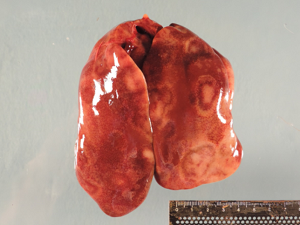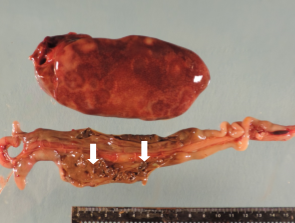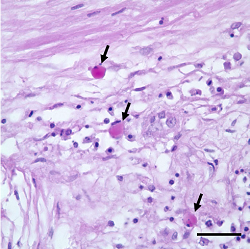By: Dr. Yuko Sato
Edited by: Dr. Pat Wakenell

Multifocal to coalescing necrotic target lesions in the liver of a turkey with histomoniasis.

Multiple pale whitish cecal worms (arrows) within a necrotic cecal lumen
Histomoniasis (blackhead) is a protozoal disease caused by Histomonas meleagridis that primarily affects the liver and ceca of turkeys and other gallinaceous birds, including chickens, peafowl, and quail. Transmission of blackhead occurs by direct contact with infected birds or infected feces, as well as indirect infection via ingestion of infected cecal worms (Heterakis gallinarum) or earthworms that contain infected cecal worms. Clinical signs develop in 6-12 days, and occur most commonly at 11 days post-infection. They include listlessness, emaciation, unkempt feathers, and yellow, sulfur-colored droppings. The name, “blackhead” is somewhat of a misnomer, as typical presentations of diseased turkeys do not include cyanosis of the head. Gross lesions are characterized by pathognomonic, necrotic target lesions in the liver and caseous cecal cores. Histopathologic lesions are characterized by numerous round to ovoid, faintly eosinophilic to golden-brown PAS-positive bodies, ranging from 10-20 μm in diameter, surrounded by a halo, within macrophages or inflammatory cellular debris in H&E stained tissue sections. Since there are no chemotherapeutic products that are approved and available for treatment of histomoniasis in the U.S., control strategies are focused on prevention. Routine deworming, cleaning of premises, and practicing good biosecurity, such as avoiding multiple species of poultry in a flock (especially chickens and turkeys), are key measures for prevention and control.

PAS-positive histomonads (arrows) in the cecum; bar = 50 µm, 100x magnification, Periodic acid-Schiff (PAS) stain.